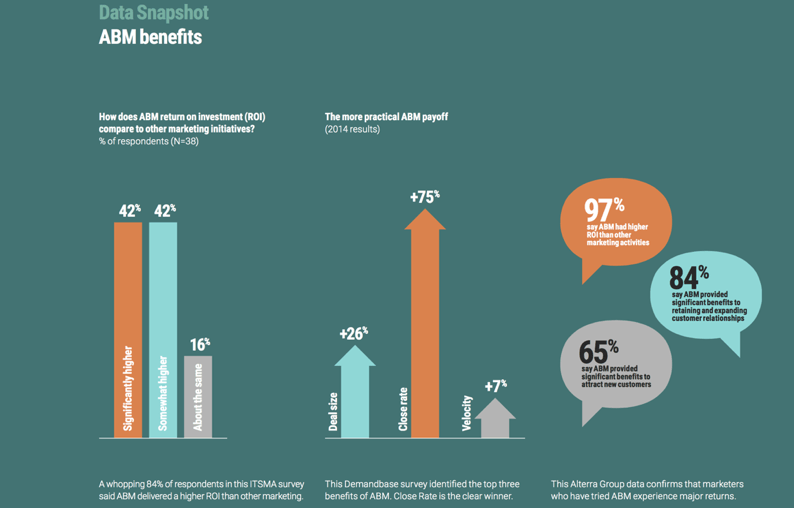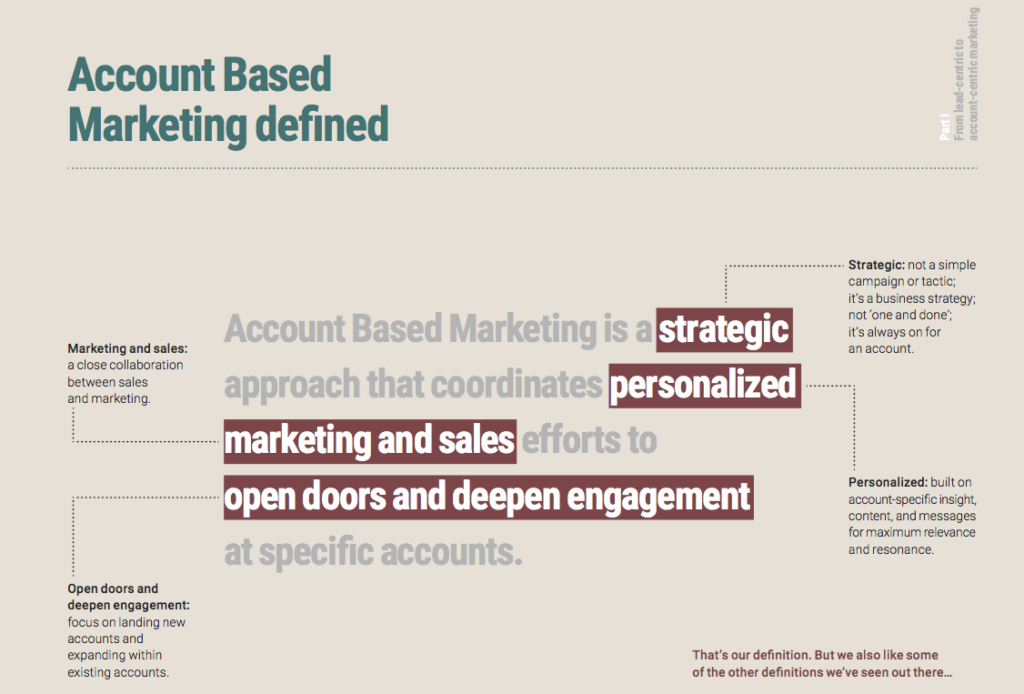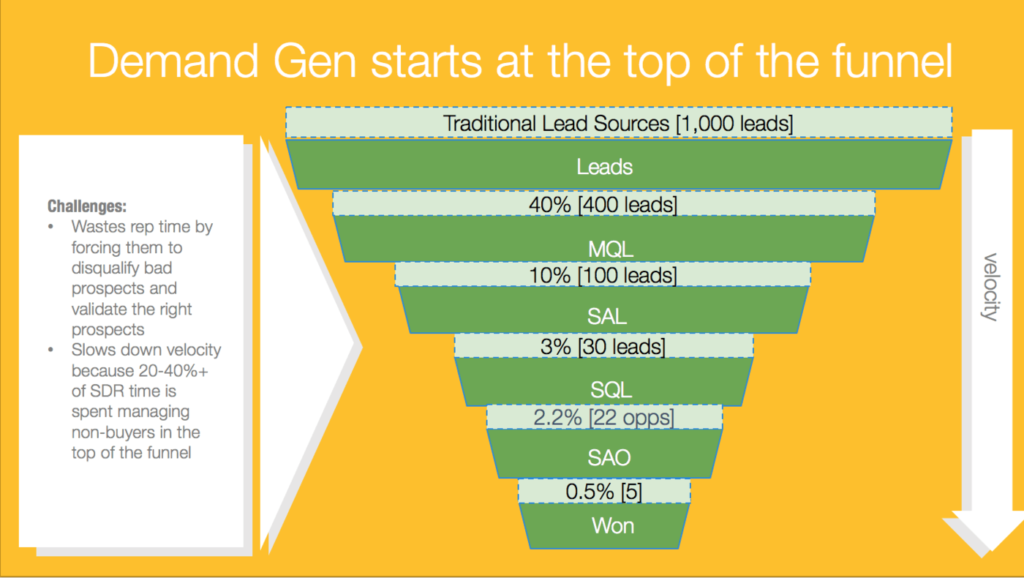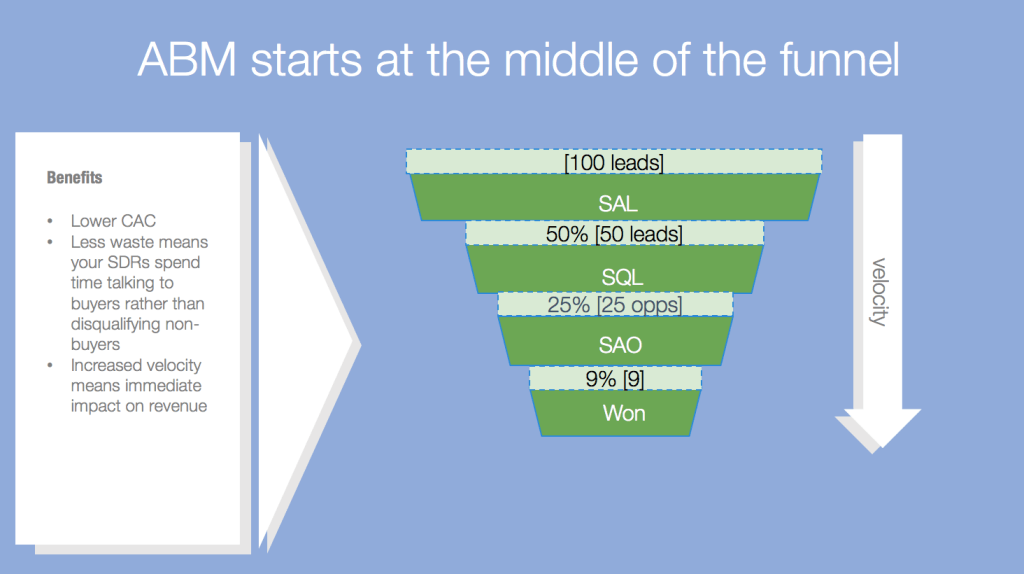Account-Based Marketing is a lot like teenage sex: Everyone’s talking about it, everyone thinks everyone else is doing it, but hardly anyone is actually doing it. And those few that are doing it are probably doing it wrong.
I’ve heard this joke used before with the subjects ranging from big data to web personalization, but the reason I bring it up with regards to ABM is because it’s absolutely true. ABM is the hottest topic in the domains of sales and marketing at the moment, and there’s a reason for it: According to the ITSMA, ABM has the highest ROI of any marketing strategy or tactic:
 Source: Engagio’s Clear & Complete Guide to ABM
Source: Engagio’s Clear & Complete Guide to ABM
But, for all the efficacy we know it can have, and for all the people who are talking about it, not many seem to actually know what it is or how to do it. That is why we are here together, now, in this moment in the space-time continuum. The purpose of this post is twofold:
- Shed some light on what ABM is, why it’s so effective, and what it means for sales teams
- Help salespeople learn how to effectively practice Account Based Selling, regardless of whether or not the organization they are a part of practices ABM [note: it’s obviously more effective to practice ABS within an organization that is practicing ABM, but sales teams will reap benefits by practicing ABS either way. They just happen to be much more pronounced when every function within the organization is bought-in and aligned]
What is ABM?
First, what is Account-Based Marketing? Well, it’s actually a bit of a misnomer, because it’s not exclusively a marketing function. According to Jeff Sands of the ITSMA, “ABM is a strategic business initiative. If it’s only sponsored by marketing, it becomes a campaign.”
I tend to agree with folks like Lars Nilsson of Cloudera who think that ABM should more accurately be called “ABM&S.”
 Source: Engagio’s definition of ABM
Source: Engagio’s definition of ABM
Account-Based Marketing and Account-Based Selling are often not adopted because of the complexity of orchestration along with the high upfront cost of adoption. ABM requires deep customer knowledge and tightly aligned efforts by sales and marketing organizations to break into target accounts. ABM is different from the juggernaut incumbent in traditional tech marketing — demand generation — in several ways:
- It’s account-centric
- It’s outbound
- It’s “land and expand”
- It supports, but doesn’t source the pipeline
- It measures different things
[Tweet “ABM requires deep customer knowledge and tightly aligned efforts by sales and marketing.”]
When done correctly, one of the reasons ABM has such a superior ROI compared to traditional demand generation is that it cuts the bad prospects out of the funnel by multiple orders of magnitude. Whereas with traditional demand generation, it typically takes hundreds of leads to produce one closed opportunity, ABM typically requires only prospects in multiples of 10 — and often far fewer than that — to produce revenue:


As seen in both the ITSMA image and the demand gen vs ABM images above, not only does ABM&S help by generating higher win-rates, faster deal cycles, and larger deal sizes [source]: it also saves salespeople valuable time. In my experience leading sales development teams, far too much of SDRs’ time is spent disqualifying non-buyers from the process. It’s not at all uncommon to only see only a single deal out of every two to three hundred inbound leads close, while a huge chunk of that same sample size is an assortment of unqualified buyers.
[Tweet “Far too much of SDRs’ time is spent disqualifying non-buyers from the process. @ashalhashim”]
If you’re a well-funded organization like Salesforce or LinkedIn, those high costs and inefficiencies are painful, but can perhaps be dismissed as a cost of doing business. However, if you’re a young startup that’s trying to fund your own growth while controlling burn; that could kill you.
The futility of other solutions
One thing that helps improve demand generation efficiency and efficacy is implementing a lead scoring solution. This allows you to surface only the leads that have a decent probability of actually turning into revenue to your sales team while putting the remainder in marketing-led nurture campaigns.
While this approach certainly helps reduce some of the operational inefficiencies on the sales development side, it is far from perfect.
One reason for this is that you are still, to quote Engagio’s Jon Miller, “fishing with nets.” Fishing with nets is inherently an act of capturing a bunch of “stuff” and then sorting out the good from the bad as a follow-up step. Adding lead scoring to demand generation is valuable, but at the end of the day, it’s the same filtering act, optimized.
The other problem with lead scoring is that most solutions in this space simply score the leads, but the algorithms that produce the score are a black box as far as the salesperson is concerned. Why did Lead A receive a score of 3X that of Lead B? The fact that this question goes unanswered creates distrust among sales teams.
When you couple this fact with the presumption that even the best lead scoring system is a probability model–which of course is never going to be 100% accurate and will produce false-positives as well as false-negatives–the credibility of leads scoring systems erodes over time.
A better way forward
Now, don’t get me wrong — demand generation and digital marketing are crucial parts of how many SaaS businesses grow. I’m certainly not advocating their elimination, nor am I making a blanket statement that companies should reduce spend on demand gen. Each company is unique in terms of what it sells, who it sells to, company maturity and market maturity. The amount of inbound a company should seek should be a function of all of those factors.
What I am saying, however, is that over-reliance on en masse inbound is not capital-efficient, and if it’s allowed to exist as the sole method for opportunity generation, customer acquisition costs will sky-rocket.
[Tweet “Over-reliance on en masse inbound is not capital efficient as a sole method for opp generation”]
Even worse, because your ideal customer profile changes over time and your later adopters will require more education than early ones [see my post on GROW-ROI and the Law of Diffusion of Innovation], not only will CAC metrics sky-rocket, LTV metrics will start to dip. This is because, without sufficient changes to the amount of education you offer pre-sale, you’re bringing more “bad buyers” into your sales cycles than you were in your early days, which will lead to higher churn.
The right solution requires a mix of demand generation and Account-Based Marketing & Sales. Let’s talk about ABM, shall we? In our next post, we’ll explore how to implement, manage, and measure ABM&S in your organization.







